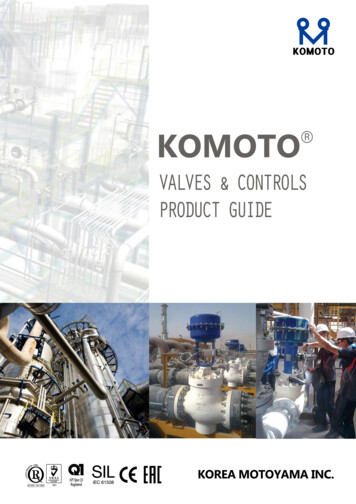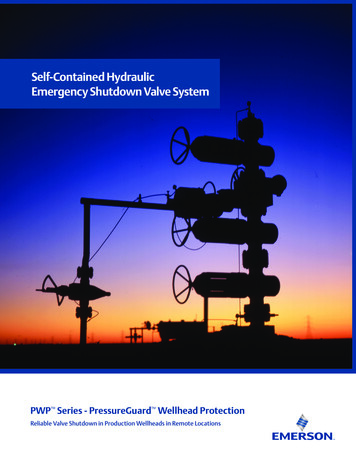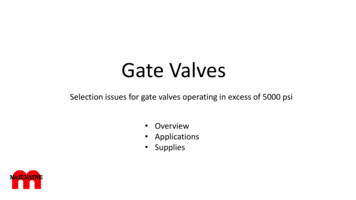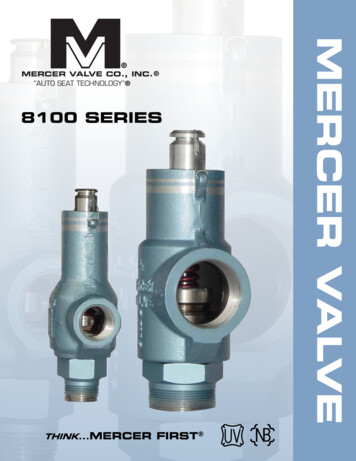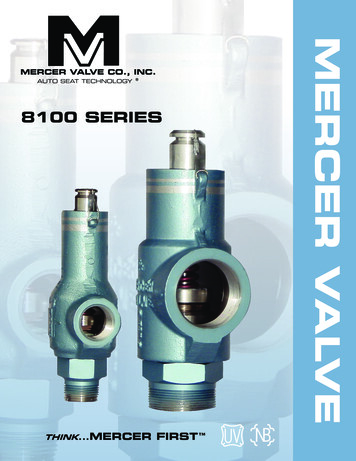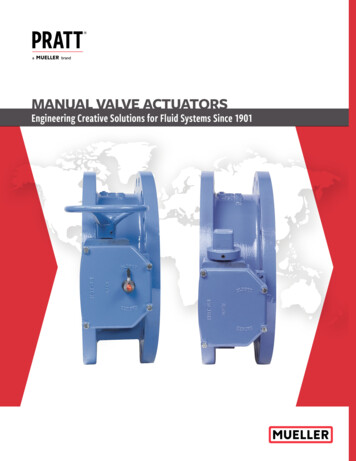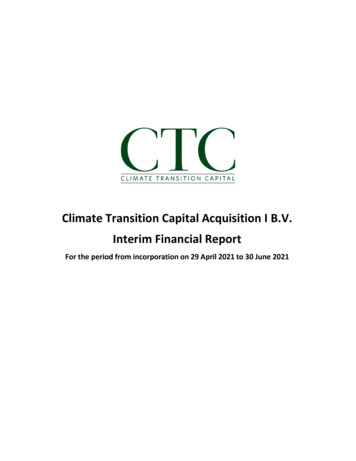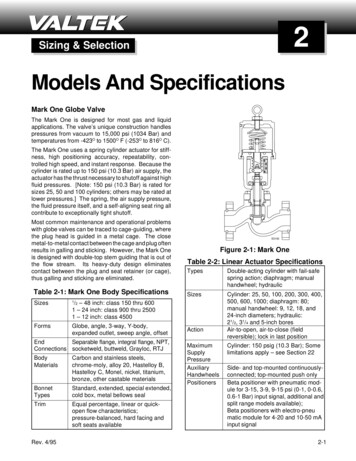
Transcription
1210112009Event#General Information or Other (PAR)Rep Org: ENGINE SYSTEMS, INCSupplier: ENGINE SYSTEMS, INCRegion:City:County:State:PagelIU.S. NuclearRegulatory Commission OperationsCenter Event Report1ROCKY MOUNT45459(EST)(EDT)Notification Date / Time: 10/23/2009 16:32Event Date / Time: 08/24/2009Last Modification: 12/01/2009Docket #:Agreement State:License #:YesNCNRC Notified by:HQ Ops Officer:Emergency Class:10 CFR Section:21.21PAUL STEPANTSCHENKBILL HUFFMANNON EMERGENCYNotifications:NEIL OKEEFEJ.THORP (e-mail)O.TABATABAI (e-mail)R4DONRRNROUNSPECIFIED PARAGRAPHINTERIM REPORT ON THERMOSTATIC VALVE FAILURE ON PALO VERDE EDG"This interim report is being issued because Engine Systems, Inc. (ESI) is not able to complete an evaluation of anidentified deviation within the 60 day requirement of 10CFR21.21. The evaluation is expected to be completed nolater than November 30, 2009."ESI began an evaluation of a thermostatic valve element failure on August 24, 2009. Palo Verde Nuclear Plantnotified ESI of the failure as a result of a failure analysis they were performing on a thermostatic valve that hadbeen removed from the lube oil system of their 2A-EDG. The element was in service since April 2008 and PaloVerde verified operation of the element prior to installation."The Palo Verde failure analysis determined that one of two elements within the valve was defective. The elementfailure was attributed to wax leakage past the diaphragm seal on one of two power pills within the element.Evidence of mechanical binding of the piston is believed to have caused the wax leakage. If the piston wasjammed, the expanding wax could have over pressurized the diaphragm seal leading to wax leakage. The failureanalysis noted the following to support piston binding:- The piston was initially difficult to remove from its guide tube.- A gouge was observed on the piston surface.- The rubber plug within the power pill exhibited brass machining chip debris."ESI has been coordinating with Palo Verde and the manufacturer (AMOT) to complete our evaluation and todetermine if this is a generic issue or if it is an isolated incident."To date, no other similar failures with AMOT thermostatic valves have been reported to ESI."J 6I9
1210112009Paze 2U.S. Nuclear Regulatory Commission OperationsCenter Event ReportGeneral Information or Other (PAR)Event#45459Palo Verde has Cooper Bessemer KSV-20T diesel engines that use one 6" thermostatic valve in the engine jacketwater system and one in the engine lube oil system to regulate system temperatures during engine operation. Thethermostatic valve is an AMOT model 6HAS. The AMOT thermostatic valve element (P/N 9760X) is the defectivepart. ESI did not provide any information on other nuclear power plants that have EDGs that utilize this modelthermostatic valve.* * * UPDATE RECEIVED VIA EMAIL FROM PAUL STEPANTSCHENKO TO DONG PARK AT 1642 EST ON12/01/09 * * *"This report is a follow-up to an interim report (1 OCFR21-0098-INT) issued by Engine Systems, Inc. (ESI) on10/23/09 which identified a deviation with an Amot thermostatic valve element. The interim report was issuedbecause ESI was not able to complete the evaluation within the 60 day requirement of 10CFR21. The evaluationwas completed on 11/30/09 and the deviation was determined be a reportable defect as by defined by 10CFR21."The Exelon analysis also reports that similar brass machining debris was observed on the plugs from the otherthree power pills to varying degrees. None of the stems of these pills displayed evidence of gouging or binding."To date, no other similar failures with Amot thermostatic valves have been reported to ESI."ESI has contacted the valve manufacturer (Amot) to discuss these findings. A copy of the Palo Verde failureanalysis and eleven (11) element assemblies from ESI inventory were sent to Amot for evaluation. The followingelements were sent to Amot for evaluation:-Qty. 8: PIN 9760 X-170' (CES PIN 2-05V-419-107)Qty. 3: PIN 9760 X-160' (CES PIN 2-05V-419-109)"Both part number elements are the same except for the temperature setting ("-170" indicates HOoF nominal and160" indicates 160'F nominal)."Upon completion of their evaluation, Amot has reported the following:-Fine shavings/powder of brass was observed in some of the element pills.%None of the pill stems had any evidence of gouging.The pills used in the 9760X elements are made by converting another part number pill. This conversion consistsof removing the stem from the pill and performing some machining. Amot believes the brass debris may haveentered the pill as a result of this conversion process.%Amot has not made any changes to this conversion process in recent history and has not had reports of similarproblems with these elements.% Machining debris, while undesirable, was evident in other pills which did not exhibit any operability issues;therefore this is not believed to be the cause of the pill failure.%The primary cause of the failure is believed to be the gouge found in the pill stem. The gouge could haveoccurred during the conversion process as the stem is removed and handled at that time.%As a precaution, Amot has made changes to their conversion process for this pill. The drilling fixture wasmodified to eliminate the possibility of chips entering the pill during the machining operation. This change wasmade effective 10/22/09.
1210112009U.S. NuclearRegulatory Commission OperationsCenter Event Reportaea345459Event#General Information or Other (PAR)"A listing of users with the thermostatic valves that contain the Amot 9760X element is provided in the table below.Thermostatic Valve - System:Lube6HAS Lube6HAS Lube6HAS"Nine Mile Point Water4HAS & 6HAS "Oconee Lube & Water6HAS "Palo Verde Lube & Water"South Texas Project - 6HAS Lube & Water6HAS"Susquehanna Lube & Water5HAS & 6HAS "Waterford "Site "Braidwood "Byron -"Corrective Action: The element failure at Palo Verde is considered to be an isolated incident related to a gouge inthe pill stem. Thus, there is no recommended corrective action for users of the Amot 9760X element. Theevaluation also indicated a weakness in Amot's manufacturing process for the element pill which introducedmachining debris. While not believed to be the cause of the Palo Verde element failure, machining debris within theelement pill is undesirable and increases the potential for failure in the future. Users with thermostatic valvescontaining Amot PIN 9760X elements should be aware of this issue so that they can monitor their systems for anyindications of thermostat element problems.Notified R1DO (Holody), R2DO (Guthrie), R3DO (Riemer), R4DO (Deese), NRR (Thorp) via e-mail, NRO(Tabatabai) via email.
ENGINE SYSTEMS, INC.1220 S. Washington St., Rocky Mount, NC 27801P.O. Box 1928, Rocky Mount, NC 27802-1928Telephone: 252/977-2720Fax: 252/446-1134.TELEFAXDate:December 1, 2009Company:NRC Operations CenterFax Number:301/816-5151Verification No.:301/816-5100Reference:Report No. IOCFR21-0098, Rev. 0From:Paul StepantschenkoPage:1 of 7Dear Sir:Following this cover is a copy of our report 1OCFR21-0098, Rev.0, for a10CFR21 reportable notification about an Amot thermostatic valve element,P/N 9760X.A copy of this report will be mailed to the NRC Document Control Desk and toour affected nuclear customers.Should you have questions, please let us know.Sincerely,ENGINE SYSTEMS, INC.Paul StepantschenkoQuality Assurance ManagerQuality Performance With Pride
ENGINE SYSTEMS, INC.175 Freight Road, Rocky Mount, NC 27804Telephone: 252/977-2720Fax: 252/446-1134Report No.Rev. 0:1OCFR21-009812/01/0910CFR21 REPORTING OF DEFECTSAND NON-COMPLIANCECOMPONENT:Amot thermostatic valve elementP/N: 9760XSYSTEM:Emergency Diesel Generator - lube oil & jacket water systemCONCLUSION:Reportable in accordance with 1OCFR21Date:Prepared By:.-/2Engineering ManagerDate:Reviewed By:Quality Assurance ManagerQuality Performance With Pride
Report No.1OCFR21-0098Record of RevisionsPage:1 of 1REVDATE012/01/09DESCRIPTIONPAGEInitial issue.
Report No.IOCFR21-00698Revision:Date:012/01/09Page:1 of 4COMPONENT:Amot thermostatic valve elementAmot P/N: 9760XPURPOSE:This report is a follow-up to an interim report (1OCFR21-0098-INT) issued by Engine Systems, Inc.(ESI) on 10/23/09 which identified a deviation with an Amot thermostatic valve element. Theinterim report was issued because ESI was not able to complete the evaluation within the 60 dayrequirement of 1OCFR21. The evaluation was completed on 11/30/09 and the deviation wasdetermined be a reportable defect as by defined by 10CFR21.SUMMARY:ESI began an evaluation of a thermostatic valve element failure on August 24, 2009. Palo VerdeNuclear Plant notified ESI of the failure as a result of a failure analysis they were performing on athermostatic valve that had been removed from the lube oil system of their 2A-EDG. The elementwas in service since April 2008 and Palo Verde verified operation of the element prior toinstallation. The Palo Verde failure analysis report, performed by Exelon Power Labs, is aproprietary document and therefore a copy is not included in this notification.The Palo Verde failure analysis determined that one of two elements within the valve wasdefective. The element failure was attributed to wax leakage past the diaphragm seal on one oftwo power pills within the element. Evidence of mechanical binding of the piston is believed tohave caused the wax leakage. If the piston was jammed, the expanding wax could have overpressurized the diaphragm seal leading to wax leakage. The failure analysis noted the following tosupport piston binding:"The piston was initially difficult to remove from its guide tube." A gouge was observed on the. piston surface."The rubber plug within the power pill exhibited brass machining chip debris.The Exelon analysis also reports that similar brass machining debris was observed on the plugsfrom the other three power pills to varying degrees. None of the stems of these pills displayedevidence of gouging or binding.To date, no other similar failures with Amot thermostatic valves have been reported to ESI.ESI has contacted the valve manufacturer (Amot) to discuss these findings. A copy of the PaloVerde failure analysis and eleven (11) element assemblies from ESI inventory were sent to Amotfor evaluation. The following elements were sent to Amot for evaluation:"Qty. 8: P/N 9760X-1 70* (CES P/N 2-05V-419-107)"Qty. 3: P/N 9760X-160* (CES P/N 2-05V-419-109)*Both part number elements are the same except for the temperature setting("-170" indicates 170'F nominal and "-160" indicates 160(F nominal).
Report No.Revision:Date:Page:1OCFR21-0098012/01/092 of 4Upon completion of their evaluation, Amot has reported the following: Fine shavings/powder of brass was observed in some of the element pills.*None of the pill stems had any evidence of gouging.*The pills used in the 9760X elements are made by converting another part number pill.This conversion consists of removing the stem from the pill and performing somemachining. Amot believes the brass debris may have entered the pill as a result of thisconversion process."Amot has not made any changes to this conversion process in recent history and has nothad reports of similar problems with these elements. Machining debris, while undesirable, was evident in other pills which did not exhibit anyoperability issues; therefore this is not believed to be the cause of the pill failure.*The primary cause of the failure is believed to be the gouge found in the pill stem. Thegouge could have occurred during the conversion process as the stem is removed andhandled at that time.*As a precaution, Amot has made changes to their conversion process for this pill. Thedrilling fixture was modified to eliminate the possibility of chips entering the pill during themachining operation. This change was made effective 10/22/09.DISCUSSION:The Amot type 9760X elements are used in the Amot type "H" thermostatic valve. These valves areused in some Cooper-Bessemer KSV diesel engine jacket water and/or lube oil systems to maintainproper system temperatures during engine operation. A very limited number of EMD diesel enginesalso use the type "H" valve in the jacket water system.Each valve uses 2 thermostatic elements, Amot type 9760X (item 2 in Figure 1). The element beinginvestigated for the Palo Verde application has a nominal temperature setting of 160"F and thereforethe element part number is 9760X-1 60.The 9760X element contains two power pills (Figure 2). The power pills contain a temperaturesensitive wax that expands with increasing temperature and provides the motive force to lift theelement off of its seat.
FIGURE 1: AMOT THERMOSTATIC VALVEFIGURE 2: VALVE ELEMENT 9760X
Report No.Revision:Date:Page:1OCFR21-0098012/01/094 of 4AFFECTED USERS:A listing of users with the thermostatic valves that contain the Amot 9760X element is provided inthe table below.LISTING OF DIESEL ENGINES WITH 9760X ELEMENTSDiesel raidwood/ByronNine Mile PointC-BC-BKSVKSV20166HAS6HASLubeLubeOconee64512 & 164HAS & 6HASPalo VerdeEMDC-BKSV206HASWaterLube & WaterSouth Texas ProjectC-BKSV206HASLube & WaterSusquehannaWaterfordLaguna Verde -C-BC-BKSVKSV20166HAS5HAS & 6HASLube & WaterLube & WaterEMD645166HASWaterMexicoCORRECTIVE ACTION:The element failure at Palo Verde is considered to be an isolated incident related to a gouge in thepill stem. Thus, there is no recommended corrective action for users of the Amot 9760X element.The evaluation also indicated a weakness in Amot's manufacturing process for the element pillwhich introduced machining debris. While not believed to be the cause of the Palo Verde elementfailure, machining debris within the element pill is undesirable and increases the potential forfailure in the future. Users with thermostatic valves containing Amot P/N 9760X elements shouldbe aware of this issue so that they can monitor their systems for any indications of thermostatelement problems.
Evidence of mechanical binding of the piston is believed to have caused the wax leakage. If the piston was jammed, the expanding wax could have over pressurized the diaphragm seal leading to wax leakage. The failure analysis noted the following to support piston binding:-The piston was initially difficult to remove from its guide tube.

